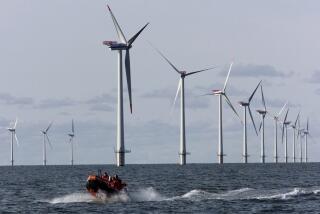Windmill Plan Could Re-energize an Industry : Environment: Danish firm wants to place 20 to 30 turbines on a San Pedro breakwater. Nearby residents are skeptical of the proposal.
- Share via
It sounds a bit quixotic, but a Danish consortium wants to make San Pedro the site of a pilot windmill program to demonstrate the advances in wind technology that is widely accepted in much of Europe.
And if the sleek 1990s windmills perform up to expectation, energy officials say the project could breathe new life into the sagging wind energy industry in the United States.
The proposal has the initial support of the South Coast Air Quality Management District, which has offered a grant for part of the project if it is approved by the Army Corps of Engineers and the California Coastal Commission.
“Our preliminary investigations have us very interested because it’s in line with our air quality goals,” said Ranji George, the AQMD’s program supervisor for technology advancement.
But residents are concerned about the aesthetics of the proposal to place 20 to 30 of the 100-foot windmills in the breakwater at the Cabrillo Beach fishing pier.
Vestas-Danish Wind Technology A/S, which applied for the permit, made the proposal after being approached by AeroVironment Inc. in Monrovia, a firm that encourages alternative sources of renewable energy.
Vestas officials say the turbines would produce enough electricity to power 3,500 to 5,000 homes each year, saving 70,000 barrels of oil and eliminating 10,000 pounds of air pollutants.
Wind turbines produce no emissions, George said. The turbines used in the Vestas project are unique, he added, because they produce much more energy than standard turbines; 20 modern turbines can do the work of 80 earlier models, he said, and they are quieter than their forerunners.
California has 15,500 windmills, which produce 1.2% of the state’s electricity. But the turbines are clumped into wind farms in the desert and in mountain passes and have a reputation for generating as much noise as electricity.
“A lot of the early projects down there just don’t produce anything,” said Alfred Jorgensen, managing partner of the Denmark-based Energy Research Consultants, a partner with Vestas. “Those really make it hard for us.”
“No question wind technology had a bad reputation in the mid-’80s. But the performance has improved so dramatically,” said Randall Swisher, executive director of the American Wind Energy Assn. in Washington. “What we didn’t realize in the early ‘80s was the fact that harnessing the wind was a much more challenging feat than anybody realized.”
Jorgensen tried to put minds at ease last week when he met with the Homeowners Coalition of San Pedro. He showed slides of similar projects in Denmark, but the idea was still met by skepticism. Most people look “at this like it was a Disneyland dream,” said resident Jerry Gaines.
Some peninsula residents said they feared that the windmills would loom like giants on a horizon beloved for its serenity.
“Don’t tell me any of those are very quiet and are not objectionable to look at,” said Jane Jones of Rancho Palos Verdes, who attended the meeting. “And the people of Palos Verdes are the ones who have to look down on our beautiful harbor.”
She argued that the water would amplify the noise. Each new turbine can generate about 32 decibels, the same as a conversation between two people, Jorgenson said, and the 20 to 30 wind turbines would be spaced about nine feet apart.
Thomas Zambrano, a senior scientist with AeroVironment, said he understands that “people just don’t want to be guinea pigs.”
“But we’re trying to convey the message that the technology is there and that it’s proven,” Zambrano said.
In Denmark, windmills provide about 5% of the nation’s energy, with a goal of 10% by 2000. The United States has no such goal for wind-generated energy, but Congress is finalizing the national energy strategy legislation, which includes a tax incentive for producers of wind-generated energy.
American windmill manufacturing experienced a boom in the mid-’80s when the federal government offered tax breaks to companies providing renewable energy sources. But those tax incentives were removed in 1986.
Meanwhile, Vestas’ primary goal is to reassure the Corps of Engineers that the San Pedro project would not harm the brown pelicans that roost near the proposed site.
The corps has asked the U.S. Department of Fish and Wildlife to review the proposal, and Vestas has hired an Orange County firm to study how the brown pelicans’ mating, roosting and flight patterns would be affected by the windmills.
More to Read
Inside the business of entertainment
The Wide Shot brings you news, analysis and insights on everything from streaming wars to production — and what it all means for the future.
You may occasionally receive promotional content from the Los Angeles Times.










